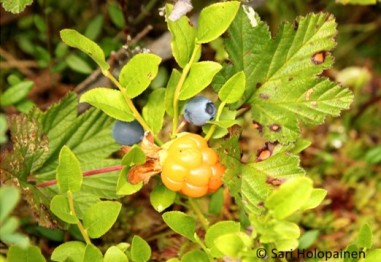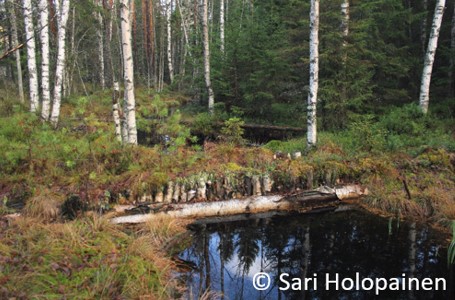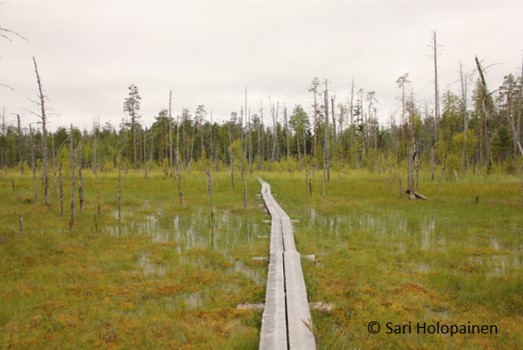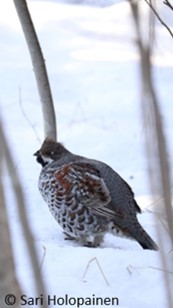In a remote country lived a rich mire species community. But that was once upon a time, when Finland was a land of mires. Nowadays, only fragmented pieces are left in the southern region, while large natural mires can still be found in Lapland. Nevertheless, only one third of historical levels remain. Most mireswere dried due to farming and forestry. Ditches were dug to gather water from ca. 6 million hectares of mires. This affected the hydrology and further the ecology of these wet ecosystems. Several plant and animal species are adapted to mires, and have thus suffered from habitat loss and fragmentation. For example, forest grouse and bean geese (Anser fabalis) utilize mires during their breeding period. Due to ditching, mires stop producing their ecosystem services, because berry production and game bird populations (these are cultural and provisioning ecosystem services), decrease, and thus the recreational values of the areas lessen.

Cloudberry (Rubus chamaemorus) grows on mires and benefits from restoration activities.
Finland has about 10 million hectares of dried mires, more than half of which have been utilized by forestry. However, about a fifth of this area does not produce wood well enough for it to be profitable. After several centuries of mire destruction, a change is now in the air. Finnish mires are being restored with increasing effort. For example, in 2017 Metsähallitus (the Park and Forest Service) began an EU-funded project called Hydrology LIFE. The project aims to safeguard not just mires, but also small water bodies and important bird lakes in 103 Natura 2000 areas. The project restores and protects mires.

Mire hydrology can be restored by blocking ditches.
Hydrology is the most important issue to consider when restoring a mire. Blocking ditches leads to changes in water balance, and eventually to active peat formation, which is basically the definition of a mire. After the ditches are blocked, water levels normally rise rapidly to correspond with the natural situation. However, actual peatland processes return at a much slower speed. Forest vegetation is slowly replaced by mire vegetation, starting from the ditches. The processes take a long time, so whether or not the original mire ecosystem returns is yet to be seen. It is also possible that we are actually just creating new mire types.

Elimyssalo nature conservation area in Eastern Finland consists of various peatland types. The area is an important calving place for wild forest reindeer (Rangifer tarandus fennicus).
Helping forest grouse

Forest grouse utilize peatland-forest ecotones. The hazel grouse (Tetrastes bonasia) population in Finland has suffered from peatland loss.
Peatland-forest ecotones are key environments for forest grouse, but unfortunately these areas are becoming very rare. The willow ptarmigan (Lagopus lagopus) has suffered from mire fragmentation in Finland. Ptarmigan habitats are fragmented especially in Southern Finland, and thus there are small populations living far from each other. Luckily, local people are usually interested in peatland restoration that helps species such as the willow ptarmigan. Several good examples exist of how ptarmigans have accepted restored peatlands. The Finnish Association for Nature Conservation has a project “SuoMaa”, which began in 2016, and targets protecting and restoring taiga nature. One of the aims is to restore peatlands to support and enlarge a ptarmigan breeding peatland network and create connections between strong and threatened populations.
Read more
Suomen metsäkanalintukantojen hoitosuunnitelma
Restoration of peatlands, Luke
